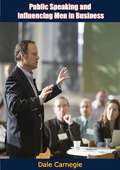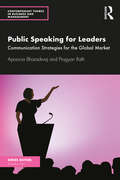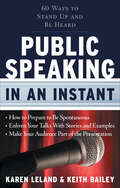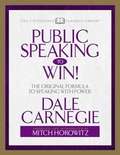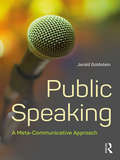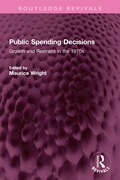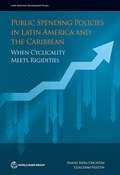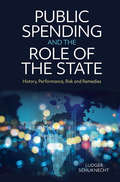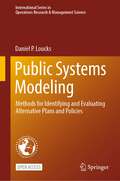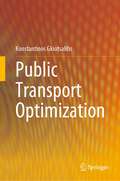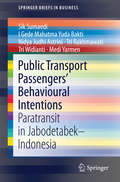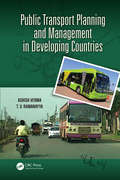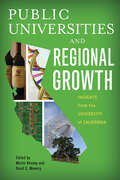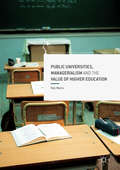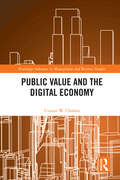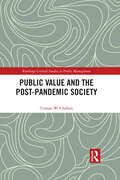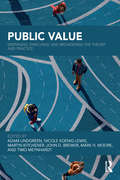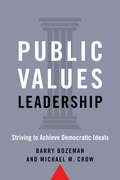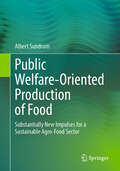- Table View
- List View
Public Services in EU Law
by Wolf SauterIn the EU public services, utilities and welfare services can be seen as both building blocks for the internal market and as a persistent irritant in the integration process. This book provides a comprehensive overview of the EU law on public services within the context of European integration. It brings together important analysis of the primary Treaty law, mainly on the internal market and competition, and of the secondary legislation at EU level, including different sector specific regimes. Particular attention is given to case law of the EU courts. This will be essential reading for those looking to have a broader understanding of the subject.
Public Speaking For Dummies, 2nd Edition
by Malcolm KushnerTried-and-true tips for dazzling your audience Conquer your public speaking jitters and deliver a dynamite speech Anxious about public speaking? Have no fear! Use this friendly guide as your personal arsenal of tools to overcome stage fright and build a rapport with your audience. From researching your topic and preparing the room to crafting a riveting address, these savvy tips will help you deliver a masterful presentation. The Dummies Way * Explanations in plain English * "Get in, get out" information * Icons and other navigational aids * Tear-out cheat sheet * Top ten lists * A dash of humor and fun Discover how to: * Speak with confidence * Create spectacular visual aids * Add power with body language * Address international and virtual audiences * Answer questions the right way
Public Speaking and Influencing Men in Business [1937 ed.]
by Dale CarnegieThe 1937 classic, still used as a cornerstone of the Dale Carnegie course, covers the entire gamut of public speaking; from preparation, format, to delivery and call to action.
Public Speaking for Leaders: Communication Strategies for the Global Market (Contemporary Themes in Business and Management)
by Pragyan Rath Apoorva BharadwajThis book studies the art of public speaking as oration instead of just ornamentation. It repositions public speaking as a fundamental business leadership act and a solution-enabling and problem-solving communication approach. Drawing on in-depth case studies, it considers various situations that a managerial leader encounters and delivers speech solutions as strategic manoeuvres for attaining desired targets. The volume: Deals with public speaking exclusively from a business perspective; Produces a workable manual of managerial public speaking that introduces the concept of oration as Or-action (oratory that leads to desired action); Presents a variegated analysis of speech texts from history, politics, fiction, social media, film industry, platform content, and business-product presentations; Customizes speeches into unique speech clusters where readers can readily find the type of speech texts they require for their own specific content development. The first of its kind, this book will be a key text for entrepreneurs, corporate managers, academic practitioners, and executives. It will also be of interest to students and researchers of behavioural economics, rhetoric, strategy, communication studies, business communication, fiction theory, generation studies, and virtual reality studies.
Public Speaking in an Instant: 60 Ways to Stand Up and Be Heard (In an Instant)
by Keith Bailey Karen LelandAn easy-to-use guide to improving your public speaking and presentation skills.The “In an Instant” series is a brand of user-friendly, engaging, and practical reference guides on core business topics, which capitalizes on the authors’ extensive experience and knowledge, as well as interviews they have conducted with leading business experts. Written in an upbeat and engaging style, the series presents 60 tips and techniques with anecdotes, examples, and exercises that the reader can immediately apply to make their work life more efficient, effective, and satisfying.Whether it’s leading a brainstorming meeting for a staff of five or giving a keynote speech to an audience of 5,000, public speaking with confidence and competency is an essential skill for success. Unfortunately, many people feel uncomfortable and even afraid when it comes to standing up and delivering a presentation. The popular comedian Jerry Seinfeld once joked that because American’s fear of public speaking was on par with their fear of death, at a funeral most people would rather be in the casket than giving the eulogy.Public Speaking in an Instant shows the reader how to make all their presentations professional, polished, and painless. The book provides time-proven techniques on writing an engaging presentation, developing an interactive style, reading and responding to an audience, and making the most of visual aids.Topics include:Use body language to get your message acrossHigh energy equals high impactThe power of silenceFocus on the message, not the slidesBe funny, not foolishThe key to spontaneity: preparation
Public Speaking to Win: The Original Formula To Speaking With Power (Abridged)
by Dale Carnegie Mitch HorowitzThe Unparalleled Classic on Speaking With Confidence and Power - In a Special Condensed Edition Here is Dale Carnegie's master class on how to speak so that people listen, available in a compact forty minutes. If you want to deliver effective sales presentations, influence clients and customers, and speak persuasively on any topic, Public Speaking to Win! is your key to success. You will discover:What REALLY grabs your listeners' attention. How to establish intimacy with your audience.How to win people's confidence. The one vital ingredient to a powerful talk. How to speak in a natural, easygoing manner. How to open and close your talk.How to move your listeners to action.Abridged and introduced by PEN Award-winning historian Mitch Horowitz, Public Speaking to Win! provides the full insight of Dale Carnegie's original guidebook, in one concise, unforgettable lesson.
Public Speaking: A Meta-Communicative Approach
by Jerald GoldsteinPublic Speaking: A Meta-Communicative Approach provides an innovative approach to acquiring public speaking skills, stressing both the theoretical underpinnings as well as the practical tools one needs to structure and deliver meaningful, dynamic presentations. It offers alternative ways of looking at public speaking: the significance of passion; a prismatic-way-of-thinking; the pervasiveness of persuasion; the assumption that teaching is taking place in every presentation; the power of meta-messages; and overarching ways to look at the public speaking enterprise. This one-of-a-kind textbook also offers real-world scenarios to equip students for speaking engagements they may face in professional contexts.
Public Spending Decisions: Growth and Restraint in the 1970s (Routledge Revivals)
by Maurice WrightFirst published in 1980, Public Spending Decisions attempts to answer some important questions regarding public spending and its relationship with economic and financial stringency. By the beginning of the 1970s the expectation of continuing economic growth had become implicit in the attitudes of politicians, administrators, and the public in Britain; likewise, the assumption of the growth of public spending had become embedded in the machinery and processes of both local and central government. How then were the local authorities and government departments affected by the abrupt halt in the growth of public spending during 1970s? How were the decisions made about the allocation of increasingly scares resources? How did the treasury ensured that the spending limits it established were not exceeded and what are the implications of changes in the attitudes of decision makers towards the growth of the public sector? The contributors are distinguished scholars in the field of local and central government. This book is a must read for scholars of public policy, public administration, finance, and economics.
Public Spending Policies in Latin America and the Caribbean: When Cyclicality Meets Rigidities (Latin American Development Forum)
by Guillermo Vuletin Daniel Riera-CrichtonIn low- and middle-income economies, public spending policies diverge significantly from those of industrialized nations due to structural differences. Low- and middle-income economies often make long-term commitments based on short-term economic conditions, leading to mismatches between spending maturity and economic cycles. These mismatches can exacerbate fiscal imbalances and hinder economic growth by forcing compositional changes in public spending. Public Spending Policies in Latin America and the Caribbean: When Cyclicality Meets Rigidities describes significant cyclical behavior variations in low- and middle-income markets. Contrary to Keynesian principles, public spending in these economies tends to be procyclical during economic booms, driven by increased borrowing and political pressures to address social deficits, but policy makers are unable or unwilling to retrench during economic busts. This approach not only amplifies macroeconomic volatility but also plants the seeds for fiscal distress, which is typically addressed by diminishing the quantity and quality of public investment—with serious consequences for long-term growth. Labor market informality further complicates matters, rendering automatic stabilizers like unemployment insurance impractical. Instead, governments rely on public employment and social transfer programs, which are downwardly rigid and can contribute to the expansion of government size over time. Addressing these anomalies requires policy interventions beyond traditional recommendations. Implementing fiscal rules to restrain overspending during economic upturns, enhancing the efficiency of public goods provision, and establishing mechanisms to adjust social programs during economic fluctuations are suggested approaches. In addition, measures to protect public investment and mitigate biases against pension benefits could aid in fostering long-term economic sustainability and welfare improvement. Public Spending Policies in Latin America and the Caribbean will be of interest to policy makers, researchers, and anyone with an interest in developing mechanisms for helping low- and middle-income economies weather economic storms.
Public Spending and the Role of the State: History, Performance, Risk and Remedies
by Ludger SchuknechtGiven high government spending, debt and the new challenges on the horizon, the themes of this work are more relevant than ever: the essential tool of spending by the state, its 'value for money', likely risks in the future, and the remedies to create lean, efficient and sustainable government. This book takes a holistic and international approach, covering most advanced countries, and discusses a historical overview of public expenditure, from the nineteenth century to the modern day, as well as future challenges. It sees the government's role as providing sound rules of the game and essential public goods and services. In presenting the relevant arguments, information and policy recommendations through comprehensive tables, charts and historical facts, the book addresses a broad readership, including students, professionals and interested members of the public.
Public Support for the Euro: Essays on Labor Productivity, Monetary Economics, and Political Economy, Vol. 2 (Contributions to Economics)
by Felix RothThe long-term sustainability of the euro and the Economic and Monetary Union (EMU) depends heavily on their ability to attract widespread public support. The support shown for the euro throughout its first two decades has helped to shield it against populist attempts at the national level to dismantle the common currency. It has granted political legitimacy to the presidents of the European Central Bank to do “whatever it takes” whenever a serious crisis has threatened the viability of the euro.Public Support for the Euro is the second of two open-access volumes presenting a selection of the author's essays on Labor Productivity, Monetary Economics, and Political Economy. This second volume brings together eleven of the author's essays, selected with the aim of providing an overview of his research to date on public support for and the economics and political economy of the euro and EMU.
Public Systems Modeling: Methods for Identifying and Evaluating Alternative Plans and Policies (International Series in Operations Research & Management Science #318)
by Daniel P. LoucksThis is an open access book discusses readers to various methods of modeling plans and policies that address public sector issues and problems. Written for public policy and social sciences students at the upper undergraduate and graduate level, as well as public sector decision-makers, it demonstrates and compares the development and use of various deterministic and probabilistic optimization and simulation modeling methods for analyzing planning and management issues. These modeling tools offer a means of identifying and evaluating alternative plans and policies based on their physical, economic, environmental, and social impacts. Learning how to develop and use the mathematical modeling tools introduced in this book will give students useful skills when in positions of having to make informed public policy recommendations or decisions.
Public Transport Optimization
by Konstantinos GkiotsalitisThis textbook provides a comprehensive step-by-step guide for new public transport modelers. It includes an introduction to mathematical modeling, continuous and discrete optimization, numerical optimization, computational complexity analysis, metaheuristics, and multi-objective optimization. These tools help engineers and modelers to use better existing public transport models and also develop new models that can address future challenges. By reading this book, the reader will gain the ability to translate a future problem description into a mathematical model and solve it using an appropriate solution method.The textbook provides the knowledge needed to develop highly accurate mathematical models that can serve as decision support tools at the strategic, tactical, and operational planning levels of public transport services. Its detailed description of exact optimization methods, metaheuristics, bi-level, and multi-objective optimization approaches together with the detailed description of implementing these approaches in classic public transport problems with the use of open source tools is unique and will be highly useful to students and transport professionals.
Public Transport Passengers' Behavioural Intentions
by Sik Sumaedi I. Gede Mahatma Yuda Bakti Nidya Judhi Astrini Tri Rakhmawati Tri Widianti Medi YarmenThis book is based on the behavioural intention of public transport passengers and the relationship between those factors in Indonesia. The conceptual model in this book explains behavioural intentions of paratransit passengers which can result in recommendations to unravel the complexity of the congestion problem from consumer behaviour perspective. Based on the results of survey research on behavioural intention of public transport users in Jabodetabek, Indonesia, the result of the study is presented in a model that describes the factors that influence. This book is recommended for academics who wish to gain knowledge about the phenomenon of consumer behaviour, for regulators whose duty is to make a decision and determine the strategic steps to overcome congestion and researchers who want to develop their knowledge and provide solutions related to congestion from the perspective of consumer behaviour.
Public Transport Planning and Management in Developing Countries
by Ashish Verma T.V. RamanayyaDeveloping Countries Have Different Transportation Issues and Requirements Than Developed CountriesAn efficient transportation system is critical for a country's development. Yet cities in developing countries are typically characterized by high-density urban areas and poor public transport, as well as lack of proper roads, parking facilities, road
Public Trust in Business
by Andrew C. Wicks Jared D. Harris Brian T. Moriarty Jared D. Harris Brian T. MoriartyPublic trust in business is one of the most important but least understood issues for business leaders, public officials, employees, NGOs and other key stakeholders. This book provides much-needed thinking on the topic. Drawing on the expertise of an international array of experts from academic disciplines including business, sociology, political science and philosophy, it explores long-term strategies for building and maintaining public trust in business. The authors look to new ways of moving forward, by carefully blending the latest academic research with conclusions for future research and practice. They address core drivers of public trust, how to manage it effectively, the consequences of low public trust, and how best to address trust challenges and repair trust when it has been lost. This is a must-read for business practitioners, policy makers and students taking courses in corporate social responsibility or business ethics.
Public Universities and Regional Growth: Insights from The University of California
by Martin Kenney David C. MoweryPublic Universities and Regional Growth examines evolutions in research and innovation at six University of California campuses. Each chapter presents a deep, historical analysis that traces the dynamic interaction between particular campuses and regional firms in industries that range from biotechnology, scientific instruments, and semiconductors, to software, wine, and wireless technologies. The book provides a uniquely comprehensive and cohesive look at the University of California's complex relationships with regional entrepreneurs. As a leading public institution, the UC is an examplar for other institutions of higher education at a time when the potential and value of these universities is under scrutiny. Any yet, by recent accounts, public research universities performed nearly 70% of all academic research and approximately 60% of federally funded R&D in the United States. Thoughtful and distinctive, Public Universities and Regional Growth illustrates the potential for universities to drive knowledge-based growth while revealing the California system as a uniquely powerful engine for innovation across its home state.
Public Universities, Managerialism and the Value of Higher Education (Palgrave Critical University Studies)
by Rob WattsThis book provides a rigorous examination into the realities of the current university system in Britain, America and Australia. The radical makeover of the higher education system which began in the 1980s has conventionally been understood as universities being transformed into businesses which sell education and research in a competitive market. This engaging and provocative book argues that this is not actually the case. Drawing on lived experience, Watts asserts that the reality is actually a consequence of contradictory government policy and new public management whose exponents talk and act ‘as-if’ universities have become businesses. The result of which is ‘market crazed governance’, whereby universities are subjected to expensive rebranding and advertising campaigns and the spread of a toxic culture of customer satisfaction surveys which ask students to evaluate their teachers and what they have learned, based on government ‘metrics’ of research ‘quality’.This has led to a situation where not only the normal teacher-student relationship is inverted, academic professional autonomy is eroded and many students are short-changed, but where universities are becoming places whose leaders are no longer prepared to tell the truth and too few academics are prepared to insist they do. An impassioned and methodical study, this book will be of great interest to academics and scholars in the field of higher education and education policy.
Public Value Theory and Budgeting: International Perspectives (Routledge International Studies in Money and Banking)
by Usman W. ChohanPublic value theory has advanced over the past 30 years, but there is a need to extend its boundary outwards into new contexts and update its discourse to reflect new social challenges. We are now trying to create value in a globalized world, with supranational entities, with new international alliances and institutions, in a frightening post-truth era. How can public managers grapple with these emerging realities? This book seeks to provide answers to such public value questions by applying powerful budgeting perspectives. Using case studies of independent budget offices, key fiscal instruments, and leading public value frameworks, this book stands out in its use of budgetary lenses to answer pertinent questions about the multidimensional processes of value creation by and for a wider society. Pushing the debate on public value forward and taking it onto the global stage, the book asks whether public value (and other public administration theories) are applicable beyond the traditional context of the pro-globalization Western liberal democracies in which they were conceived. It does this by exploring the realms of developing countries, supranational entities, and post-Communist societies, among others. Finally, it presents these explorations in light of very recent sociopolitical trends and phenomena, including the growth of civil society, the global financial crisis, the illiberal democracy, and the post-truth era. Tailored to an audience comprising public administration scholars, students of government, budget practitioners, and social scientists interested in contemporary problems of values in society, this book helps to advance public administration thought by extending public value theory into new contexts and relating it to the growing global challenges of public life.
Public Value and the Digital Economy (Routledge Advances in Management and Business Studies)
by Usman W. ChohanHow can the public manager create and co-create value in the digital economy? While there is much exciting work being done, there is a pressing need to recontextualize public value theory (PVT), specifically in terms of its theoretical precepts, in the fluid and dynamic environment that the digital economy has produced. Much of the theoretical undergirding of PVT predates the full onset of today’s digital economy, leaving aside phenomena including citizen-driven innovations, decentralized digital structures, and the algorithmic foundations of new economic life. This is why a conceptually driven exercise in contemporizing PVT would be of great value to public administration’s theoreticians seeking to lead the theory in catching up to the praxis. This book seeks to answer the question of creating and co-creating public managerial value by presenting chapters that revisit categories central to the functions of public managers in relation to other value-creating agents under PVT. It introduces new and important lenses to PVT that are grounded in the praxis of the digital economy, raising new questions about old problems in PVT and generating newer formulations that push PVT forward and make its debates salient to the futures that lay before the modern public manager. The book therefore constitutes an important effort to take PVT forward by shedding new light on the potency of the public manager in confronting and constructing the digital economy through co-creation with the other agents of public value. It will be of interest to researchers, academics, and policy makers in the fields of public and nonprofit management, public administration and policy, and PVT.
Public Value and the Post-Pandemic Society (Routledge Critical Studies in Public Management)
by Usman W. ChohanThe destruction of the Covid-19 pandemic has marked every society with deep-seated wounds whose scars have only begun to heal. Yet, even as societies take their first steps away from the trauma of the pandemic, they confront new and perhaps equally daunting challenges in the post-Covid era. These challenges offer a unique occasion to consider how the mechanisms of public value (PV) creation and preservation can be rebuilt and improved, mindful of what has been left in the pandemic’s wake, and of the difficult road that lies ahead. The aim of this book, then, is to examine the forward-looking possibilities of multi-stakeholder value co-creation, which involves the renewed efforts of civil society, public managers, politicians, and society-at-large in a new post-pandemic era. The book examines many different facets that appeal deeply to public value scholarship: value stability & transitions, inequalities within & between publics, necropolitics, disaster preparedness, value measurement, and sustainability, all of which represent important explorations within public value theory, and can greatly enrich PV research going forward. This book will therefore be of use to both academics and practitioners of public administration and public policy, as well as scholars of government, health care policy, and economics.
Public Value: Deepening, Enriching, and Broadening the Theory and Practice
by Mark H. Moore John D. Brewer Timo Meynhardt Martin Kitchener Adam Lindgreen Nicole Koenig-LewisOver the last 10 years, the concept of value has emerged in both business and public life as part of an important process of measuring, benchmarking, and assuring the resources we invest and the outcomes we generate from our activities. In the context of public life, value is an important measure on the contribution to business and social good of activities for which strict financial measures are either inappropriate or fundamentally unsound. A systematic, interdisciplinary examination of public value is necessary to establish an essential definition and up-to-date picture of the field. In reflecting on the ‘public value project’, this book points to how the field has broadened well beyond its original focus on public sector management; has deepened in terms of the development of the analytical concepts and frameworks that linked the concepts together; and has been applied increasingly in concrete circumstances by academics, consultants, and practitioners. This book covers three main topics; deepening and enriching the theory of creating public value, broadening the theory and practice of creating public value to voluntary and commercial organisations and collaborative networks, and the challenge and opportunity that the concept of public value poses to social science and universities. Collectively, it offers new ways of looking at public and social assets against a backdrop of increasing financial pressure; new insights into changing social attitudes and perceptions of value; and new models for increasingly complicated collaborative forms of service delivery, involving public, private, and not-for-profit players.
Public Values Leadership: Striving to Achieve Democratic Ideals
by Barry Bozeman Michael M. CrowInstead of private gain or corporate profits, what if we set public values as the goal of leadership?Leadership means many things and takes many forms. But most studies of the topic give little attention to why people lead or to where they are leading us. In Public Values Leadership, Barry Bozeman and Michael M. Crow explore leadership that serves public values—that is to say, values that are focused on the collective good and fundamental rights rather than profit, organizational benefit, or personal gain. While nearly everyone agrees on core public values, there is less agreement on how to obtain them, especially during this era of increased social and political fragmentation. How does public values leadership differ from other types of organizational leadership, and what distinctive skills does it require? Drawing on their extensive experience as higher education leaders, Bozeman and Crow wrestle with the question of how to best attain universally agreed-upon public values like freedom, opportunity, health, and security. They present conversations and interviews with ten well-known leaders—people who have achieved public values objectives and who are willing to discuss their leadership styles in detail. They also offer a series of in-depth case studies of public values leadership and accomplishment. Public values leadership can only succeed if it includes a commitment to pragmatism, a deep skepticism about government versus market stereotypes, and a genuine belief in the fundamental importance of partnerships and alliances. Arguing for a "mutable leadership," they suggest that different people are leaders at different times and that ideas about natural leaders or all-purpose leaders are off the mark. Motivating readers, including students of public policy administration and practitioners in public and nonprofit organizations, to think systematically about their own values and how these can be translated into effective leadership, Public Values Leadership is highly personal and persuasive.
Public Welfare-Oriented Production of Food: Substantially New Impulses for a Sustainable Agro-Food Sector
by Albert SundrumFood is a means of life. The way it is produced affects us all. Largely unnoticed by the public, a system of the agricultural and food industry has developed in recent decades that supplies us with an abundance of food at excessively low prices. However, the undesirable side effects and external costs of this system have long been ignored. Enormous environmental and climate impacts, loss of biodiversity, animal welfare problems and the continuing death of farms only inadequately describe the true extent of the harmful effects. In the interests of the public welfare, these can no longer be tolerated. However, the complexity of the issues and the diversity of vested interests stand in the way of simple solutions. This professional book provides a comprehensive systemic analysis from very different perspectives and explains how this development has come about. It shows what fundamental changes are needed in all areas in order to find a way out of the destructive pursuit ofcost minimisation through evidence-based quality production. Professionals in the agricultural and food industry and the scientific disciplines involved, including veterinary medicine, as well as decision-makers in political institutions, professional associations and NGOs can use this knowledge to redesign the food sector for the future.
Public Workers in Service of America: A Reader (Working Class in American History)
by Eileen Boris Jon Shelton Katherine Turk Amy Zanoni William Powell Jones Cathleen D Cahill Joseph E Slater Francis RyanFrom white-collar executives to mail carriers, public workers meet the needs of the entire nation. Frederick W. Gooding Jr. and Eric S. Yellin edit a collection of new research on this understudied workforce. Part One begins in the late nineteenth- and early twentieth century to explore how questions of race, class, and gender shaped public workers, their workplaces, and their place in American democracy. In Part Two, essayists examine race and gender discrimination while revealing the subtle contemporary forms of marginalization that keep Black men and Black and white women underpaid and overlooked for promotion. The historic labor actions detailed in Part Three illuminate how city employees organized not only for better pay and working conditions but to seek recognition from city officials, the public, and the national labor movement. Part Four focuses on nurses and teachers to address the thorny question of whether certain groups deserve premium pay for their irreplaceable work and sacrifices or if serving the greater good is a reward unto itself. Contributors: Eileen Boris, Cathleen D. Cahill, Frederick W. Gooding Jr., William P. Jones, Francis Ryan, Jon Shelton, Joseph E. Slater, Katherine Turk, Eric S. Yellin, and Amy Zanoni


